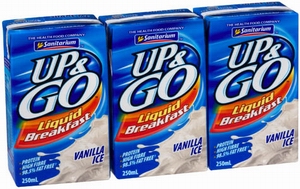 Food manufacturer Sanitarium has rejected claims from Australian consumer group CHOICE that health claims on Sanitarium’s Up & Go liquid breakfast products are “shonky”. CHOICE had claimed that the Sanitarium product was one of several popular liquid breakfast products carrying “dodgy nutritional claims”.
Food manufacturer Sanitarium has rejected claims from Australian consumer group CHOICE that health claims on Sanitarium’s Up & Go liquid breakfast products are “shonky”. CHOICE had claimed that the Sanitarium product was one of several popular liquid breakfast products carrying “dodgy nutritional claims”.But Sanitarium said its product meets the standard set by the Code of Practice on Nutrient Claims (CoPoNC), which previously was recognised by Food Standards Australia New Zealand (FSANZ)’s predecessor body. According to Sanitarium, the CoPoNC states that a food product must contain no less than 3 grams of fibre per serve to claim it is “high in fibre”.
“Sanitarium Up & Go fibre content of 3.8 grams is well in excess of the Code of Practice [CoPoNC] requirement to enable a ‘high fibre’ content claim,” said Michelle Reid, APD and Nutritionist for Sanitarium.
“If liquid breakfasts contained 20 per cent fibre, as CHOICE proposes for a high fibre claim, there would be 50 grams of fibre per serve – which is almost double the recommended daily intake – and no doubt inedible. It would be like eating 1.5 loaves of wholegrain bread a day,” Ms Reid said.
CHOICE made the claims after an investigation into 23 liquid breakfast products, including Sanitarium’s Up & Go, Devondale Fast Start, Kellogg’s breakfast drinks, Vitasoy Vitago, Dairy Farmers Oats Express and Aldi Goldenvale Quick Start.
“Shonky claims on liquid breakfasts such as ‘high in fibre’, ‘fibre for digestive health’, and ‘goodness of three grains’ is a cause for concern,” said Tom Godfrey, CHOICE spokesperson. “Liquid breakfasts have on average 1.5 per cent fibre, which is well below the 10 per cent benchmark for high fibre. It is grains away from the 39.5 per cent fibre offered by some bran cereals,” he said.
CHOICE claims its investigation also found that “10 of the 23 products investigated have more than 23g of sugar per serve – roughly the same as a chocolate bar”.
“If it’s energy you are after, the breakfast drinks CHOICE reviewed ranged from 700kj to 912kj and fall short of a regular meal that comes in at 2,000kj. So, if you are looking for convenience and want to avoid mid-morning snacking, reach for a tub of yoghurt and grab an apple,” Mr Godfrey said.
Alternatives to CoPoNC
Under Australia’s new Nutrition, Health and Related Claims standard, which became operational under a 3-year transition period from mid-January 2013 – and which (according to legal experts) is expected to supersede CoPoNC – some dietary fibre claims are permitted if a product contains only 2g of dietary fibre in a serving of the food (or less if the claim is about low or reduced dietary fibre).
The new Nutrition, Health and Related Claims Standard requires any product with a claim of “excellent source of dietary fibre” to have at least 7g of dietary fibre in the serving and a “good source” claim requires at least 4g of dietary fibre per serving under this new Food Standard.
At the same time, CHOICE’s threshold - that suggests a minimum of 20 percent fibre - does not appear to be supported by any government law or industry code or recent scientific findings.
Australian Food News reported on several occasions in 2012 about scientific findings concerning health benefits of resistant starches as part of a fibre combination, as well as other recent studies which demonstrated that the amount of fibre-content by itself does not necessarily tell the full story about health benefits or nutritional value of the product.
Breakfast drinks category
Liquid breakfasts are a growing category in supermarket aisles. While Sanitarium’s Up & Go has ruled the market since its launch 15 years ago, selling more than 34 million litres through supermarkets in the past 12 months, other manufacturers have since entered the battle for shelf space.
According to data from market research organisation Nielsen, published in the ‘Retail World Grocery Guide 2012’, Sanitarium had 100 per cent share of both value and volume in the portable liquid breakfast cereal category in 2012. Brand share was split between Up & Go (95.5 per cent value, 95.4 per cent volume) and Up & Go Vive (4.5 per cent value, 4.6 per cent volume).







